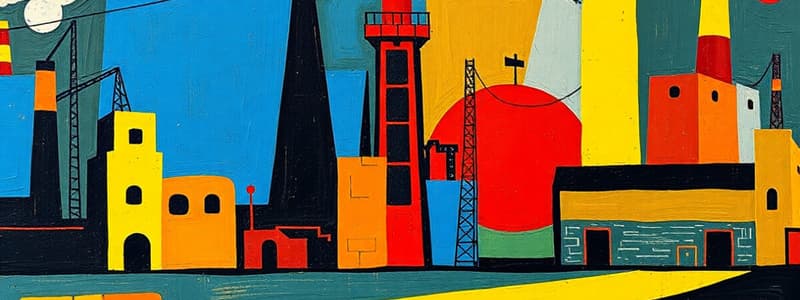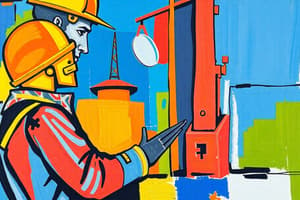Podcast
Questions and Answers
How does studying Industrial Arts contribute to self-sufficiency and financial well-being?
How does studying Industrial Arts contribute to self-sufficiency and financial well-being?
- By focusing on theoretical knowledge that prepares individuals for advanced academic studies.
- By primarily teaching artistic skills that lead to high-paying creative careers.
- By enabling individuals to independently address common maintenance and repair issues, reducing expenses and improving safety. (correct)
- By offering skills that are only applicable in large-scale industrial settings, increasing job security.
How did the availability of natural resources impact the Industrial Revolution?
How did the availability of natural resources impact the Industrial Revolution?
- It shifted the focus from industrial advancements to agricultural improvements.
- It decreased the pace of urbanization due to reliance on rural resources.
- It provided the necessary raw materials like coal and iron, fueling the machines and factories that drove industrial growth. (correct)
- It had no impact, as the revolution was driven solely by technological advancements.
In what primary way did improved farming methods contribute to the Industrial Revolution?
In what primary way did improved farming methods contribute to the Industrial Revolution?
- By increasing the demand for skilled agricultural labor, thereby slowing urbanization.
- By directly incorporating industrial technologies into agricultural practices.
- By reducing the need for farm labor, leading to increased urbanization as people sought work in cities. (correct)
- By decreasing the efficiency of food production, leading to a need for industrial solutions.
How are digital tools and technologies impacting modern Industrial Arts education in the context of the Fourth Industrial Revolution?
How are digital tools and technologies impacting modern Industrial Arts education in the context of the Fourth Industrial Revolution?
Which capabilities are emphasized as new essential skills in the Industrial Arts due to the Fourth Industrial Revolution?
Which capabilities are emphasized as new essential skills in the Industrial Arts due to the Fourth Industrial Revolution?
Which of the following best describes the primary focus of work simplification within the context of industrial arts?
Which of the following best describes the primary focus of work simplification within the context of industrial arts?
Which of the following technological advancements is LEAST associated with the Fourth Industrial Revolution?
Which of the following technological advancements is LEAST associated with the Fourth Industrial Revolution?
How did the establishment of guilds in the Middle Ages primarily contribute to the development of industrial arts?
How did the establishment of guilds in the Middle Ages primarily contribute to the development of industrial arts?
Which of the following most accurately describes a key IMPACT of the Industrial Revolution?
Which of the following most accurately describes a key IMPACT of the Industrial Revolution?
In what way does Industrial Arts education in the 21st century differ most significantly from that of the early 20th century?
In what way does Industrial Arts education in the 21st century differ most significantly from that of the early 20th century?
Which challenge is most closely associated with the widespread adoption of automation and AI in the Fourth Industrial Revolution?
Which challenge is most closely associated with the widespread adoption of automation and AI in the Fourth Industrial Revolution?
How did the invention of the steam engine directly influence the trajectory of the Industrial Revolution?
How did the invention of the steam engine directly influence the trajectory of the Industrial Revolution?
Which of the following best illustrates how the integration of 3D printing into modern Industrial Arts education enhances learning outcomes?
Which of the following best illustrates how the integration of 3D printing into modern Industrial Arts education enhances learning outcomes?
Flashcards
Real-world problem-solving
Real-world problem-solving
Industrial Arts skills help solve practical issues like fixing leaks or repairs.
Self-reliance
Self-reliance
Industrial Arts knowledge enables individuals to perform tasks independently, saving money.
Impact of the Industrial Revolution
Impact of the Industrial Revolution
New inventions and methods improved production efficiency and transformed economies.
Fourth Industrial Revolution
Fourth Industrial Revolution
Signup and view all the flashcards
New Skills in Industrial Arts
New Skills in Industrial Arts
Signup and view all the flashcards
Industrial Arts
Industrial Arts
Signup and view all the flashcards
Industrial Revolution
Industrial Revolution
Signup and view all the flashcards
Work Simplification
Work Simplification
Signup and view all the flashcards
Vocational Education
Vocational Education
Signup and view all the flashcards
Guilds
Guilds
Signup and view all the flashcards
Digital Fabrication
Digital Fabrication
Signup and view all the flashcards
Automation
Automation
Signup and view all the flashcards
Study Notes
Industrial Arts Overview
- Industrial Arts is a subject teaching practical skills using tools and machines.
- Industrial Arts Education involves object creation using various tools and techniques.
- Technology is crucial in Industrial Arts; it includes engineering, applied science, and pure science.
- Work Simplification streamlines tasks for efficiency.
The Industrial Revolution
- The Industrial Revolution (late 18th century) transitioned societies from agrarian to industrialized economies.
- Key innovations included the steam engine, mechanized factories, and mass production.
- This revolution increased urbanization, boosted productivity, and changed daily life and work.
The Fourth Industrial Revolution
- This revolution integrates physical, digital, and biological worlds.
- Innovations include artificial intelligence (AI), automation, the Internet of Things (IoT), 3D printing, and blockchain.
- This revolution improves efficiency, creates new business models, and enhances connectivity.
- Challenges include privacy concerns, job displacement, and ethical considerations.
History of Industrial Arts
- Early Beginnings: Industrial Arts began in prehistoric times with tool creation in ancient Egypt and Mesopotamia. Early civilizations developed craftsmanship in wood, stone, and metal.
- Middle Ages: Guilds trained artisans in trades like blacksmithing, carpentry, and textiles. These guilds preserved and passed-down construction and manufacturing skills.
- Industrial Revolution: Factories and machinery shifted traditional skills towards mass production. Key inventions (steam engine, spinning jenny, power loom) revolutionized manufacturing, mainly textiles. This era transitioned from manual to machine-based production..
- Early 20th Century: Industrial Arts education became formalized in schools. Curricula focused on practical skills like woodworking, metalworking, drafting, automotive, and electrical. Vocational education gained importance as industries expanded.
- Late 20th Century: Industrial Arts embraced computer-aided design (CAD), robotics and digital fabrication. Students learned to use 3D printers and CNC machines.
- 21st Century: Industrial Arts adapts to the Fourth Industrial Revolution. Technologies like robotics, 3D printing, and automation are integrated into manufacturing processes. Educational programs blend traditional craftsmanship with digital skills, coding, and engineering.
Importance of Industrial Arts
- Real-world problem-solving: Industrial Arts skills address common issues in homes, schools, and organizations. Examples include plumbing, electrical work, and automotive repairs.
- Self-reliance and cost-saving: Industrial Arts knowledge enables individuals to handle tasks independently, saving money and improving safety.
- Careers: Industrial Arts graduates are prepared for careers in manufacturing, design, and related fields. These skills are essential for industry innovation and problem-solving.
The Impact of the Industrial Revolution
- The Industrial Revolution was driven by new inventions (steam engine, textile machines) increasing production, improved farming methods reducing farm labor and increasing urbanization, available natural resources (coal, iron for machines and factories), and business investment/government support for industry.
- The Industrial Revolution highlighted technology's ability to drastically improve production and the economy, transforming lifestyles from rural to urban settings. It emphasized adapting to new technologies and managing the social and environmental effects of rapid industrialization.
The Impact of the Fourth Industrial Revolution on Industrial Arts
- Advanced Technologies: The Fourth Industrial Revolution introduces automation, AI, 3D printing, and robotics to traditional craftsmanship and manufacturing. These technologies boost precision, efficiency, and customization in industries like woodworking, metalworking.
- Digital Tools: Students learn CAD software and 3D printing, allowing more complex and creative projects.
- New Skills: Emphasis is on programming, robotics, and digital fabrication, preparing students for careers in both traditional and emerging industries.
- The Future: The 21st century sees the Fourth Industrial Revolution impacting Industrial Arts through new technologies, leading to smarter, more precise, and customized product creation.
Studying That Suits You
Use AI to generate personalized quizzes and flashcards to suit your learning preferences.




